The Utilities sector ranks eighth out of the ten sectors as detailed in my sector roadmap. It gets my Dangerous rating, which is based on aggregation of ratings of 9 ETFs and 39 mutual funds in the Utilities sector as of April 17, 2012.
Figure 1 ranks from best to worst the eight Utilities ETFs that meet our liquidity standards. Figure 2 shows the 5 best and worst-rated Utilities mutual funds.
To identify the best and avoid the worst ETFs and mutual funds within the Utilities sector, investors need a predictive rating based on (1) stocks ratings of the holdings and (2) the all-in expenses of each ETF and mutual fund. Investors need not rely on backward-looking ratings.
The best ETFs and mutual funds allocate more value to Attractive-or-better-rated stocks than the worst, which allocate too much value to Neutral-or-worse-rated stocks.
Investors should not buy any Utilities ETFs or mutual funds because none get an Attractive-or-better rating. If you must have exposure to this sector, you should buy a basket of Attractive-or-better rated stocks and avoid paying undeserved fund fees. Active management has a long history of not paying off.
Figure 1: ETFs Ranked from Best to Worst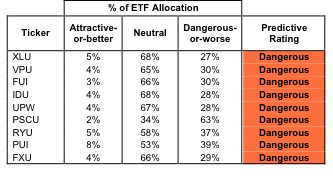
Sources: New Constructs, LLC and company filings
Figure 2: Mutual Funds with the Best & Worst Ratings – Top 5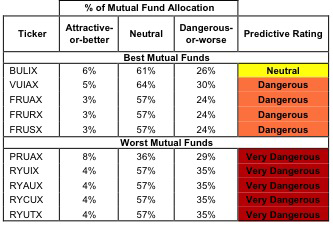
Best mutual funds exclude funds with TNA’s less than 100 million for inadequate liquidity.
Sources: New Constructs, LLC and company filings
All nine Utilities ETFs earn my Dangerous rating. American Century Quantitative Equity Funds, Inc: Utilities Fund (BULIX) is my top-rated Utilities mutual fund and is the only Utilities sector fund to earn my Neutral rating.
First Trust Utilities AlphaDEX Fund (FXU)] is my worst-rated Utilities ETF and earns my Dangerous rating, along with all 8 other Utilities ETFs. Guggenheim Investments Utilities Fund (RYUTX) is my worst-rated Utilities mutual fund and earns my Very Dangerous rating.
Figure 3 shows that 10 out of the 150 stocks (over 6% of the total net assets) held by Utilities ETFs and mutual funds get an Attractive-or-better rating. However, none of the 9 Utilities ETFs and or the 39 Utilities mutual funds get an Attractive-or-better rating.
Figure 3 shows mutual fund managers allocate too much capital to low-quality stocks and Utilities ETFs hold poor quality stocks.
Figure 3: Utilities Sector Landscape For ETFs, Mutual Funds & Stocks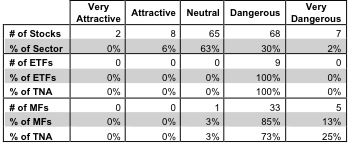
Sources: New Constructs, LLC and company filings
Investors should not buy any Consumer Discretionary ETFs and mutual funds. Instead, they should focus on individual holdings.
For example, Public Service Electric & Gas Company (PEG) is one of my favorite stocks held by Utilities ETFs and mutual funds. It earns my Attractive rating. PEG is a rarity in the Utilities sector – a business with positive economic earnings and a cheap valuation. PEG has generated a return on invested capital (ROIC) above its weighted average cost of capital (WACC) in four of the last five years. Its current stock price (~$30.02) implies the company’s profits will permanently decline by 38%. The market is setting a low bar, and PEG has demonstrated that it can generate cash flows.
Integrys Energy Group, Inc (TEG) is one of my least favorite stocks held by Utilities ETFs and mutual funds. It earns my Very Dangerous rating. In a bad sector, TEG is among the worst. TEG has misleading earnings – its economic earnings are negative and declining while its reported accounting earnings are positive and increasing. The positive accounting earnings shouldn’t mislead diligent investors; TEG is a regular value destroyer, with negative economic earnings in all but one of the last 14 years. TEG’s current valuation (~$52.21) implies that the company will grow its profits by 11% annually over the next 10 years, which seems quite unlikely given the company’s history. TEG’s price is too high for the risk it presents.
87 stocks of the 3000+ I cover are classified as Utilities stocks, but due to style drift, Utilities ETFs and mutual funds hold 150 stocks.
Figures 4 and 5 show the rating landscape of all Utilities ETFs and mutual funds.
Our sector roadmap report ranks all sectors and highlights those that offer the best investments.
Figure 4: Separating the Best ETFs From the Worst ETFs
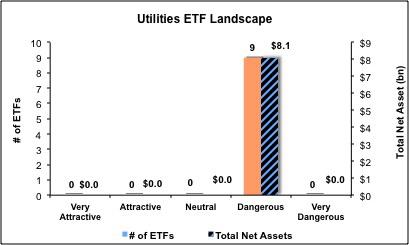
Sources: New Constructs, LLC and company filings
Figure 5: Separating the Best Mutual Funds From the Worst Mutual Funds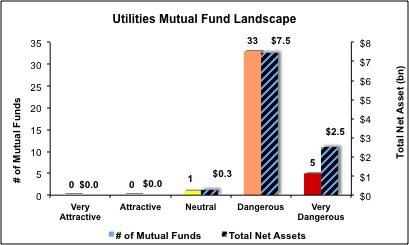
Sources: New Constructs, LLC and company filings
Disclosure: I receive no compensation to write about any specific stock, sector or theme.
- English (UK)
- English (India)
- English (Canada)
- English (Australia)
- English (South Africa)
- English (Philippines)
- English (Nigeria)
- Deutsch
- Español (España)
- Español (México)
- Français
- Italiano
- Nederlands
- Português (Portugal)
- Polski
- Português (Brasil)
- Русский
- Türkçe
- العربية
- Ελληνικά
- Svenska
- Suomi
- עברית
- 日本語
- 한국어
- 简体中文
- 繁體中文
- Bahasa Indonesia
- Bahasa Melayu
- ไทย
- Tiếng Việt
- हिंदी
Best And Worst ETFs (And Mutual Funds): Utilities Sector
Published 04/22/2012, 06:17 AM
Updated 07/09/2023, 06:31 AM
Best And Worst ETFs (And Mutual Funds): Utilities Sector
Latest comments
Loading next article…
Install Our App
Risk Disclosure: Trading in financial instruments and/or cryptocurrencies involves high risks including the risk of losing some, or all, of your investment amount, and may not be suitable for all investors. Prices of cryptocurrencies are extremely volatile and may be affected by external factors such as financial, regulatory or political events. Trading on margin increases the financial risks.
Before deciding to trade in financial instrument or cryptocurrencies you should be fully informed of the risks and costs associated with trading the financial markets, carefully consider your investment objectives, level of experience, and risk appetite, and seek professional advice where needed.
Fusion Media would like to remind you that the data contained in this website is not necessarily real-time nor accurate. The data and prices on the website are not necessarily provided by any market or exchange, but may be provided by market makers, and so prices may not be accurate and may differ from the actual price at any given market, meaning prices are indicative and not appropriate for trading purposes. Fusion Media and any provider of the data contained in this website will not accept liability for any loss or damage as a result of your trading, or your reliance on the information contained within this website.
It is prohibited to use, store, reproduce, display, modify, transmit or distribute the data contained in this website without the explicit prior written permission of Fusion Media and/or the data provider. All intellectual property rights are reserved by the providers and/or the exchange providing the data contained in this website.
Fusion Media may be compensated by the advertisers that appear on the website, based on your interaction with the advertisements or advertisers.
Before deciding to trade in financial instrument or cryptocurrencies you should be fully informed of the risks and costs associated with trading the financial markets, carefully consider your investment objectives, level of experience, and risk appetite, and seek professional advice where needed.
Fusion Media would like to remind you that the data contained in this website is not necessarily real-time nor accurate. The data and prices on the website are not necessarily provided by any market or exchange, but may be provided by market makers, and so prices may not be accurate and may differ from the actual price at any given market, meaning prices are indicative and not appropriate for trading purposes. Fusion Media and any provider of the data contained in this website will not accept liability for any loss or damage as a result of your trading, or your reliance on the information contained within this website.
It is prohibited to use, store, reproduce, display, modify, transmit or distribute the data contained in this website without the explicit prior written permission of Fusion Media and/or the data provider. All intellectual property rights are reserved by the providers and/or the exchange providing the data contained in this website.
Fusion Media may be compensated by the advertisers that appear on the website, based on your interaction with the advertisements or advertisers.
© 2007-2025 - Fusion Media Limited. All Rights Reserved.
